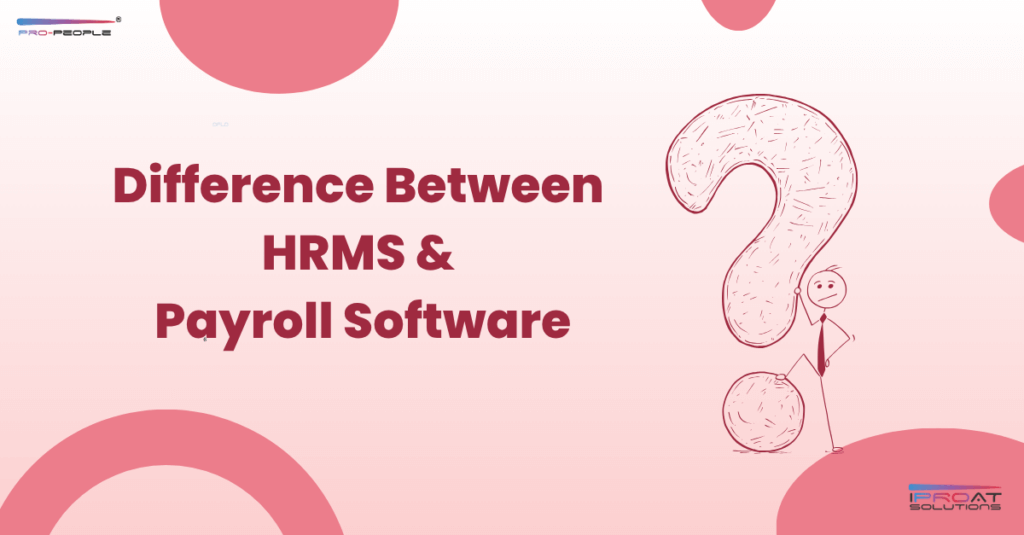
HRMS and Payroll Software: What’s the Difference?
Posted on June 19, 2025 | By Bharani
4 Min Read
- Introduction: Why Understanding This Difference Matters
- What Is Payroll Software?
- What Is HRMS (Human Resource Management System)?
- Major Differences Between HRMS and Payroll Software
- Which One Should You Choose for Your Business?
- Conclusion: Make an Informed HR Tech Decision
- Looking for HRMS and Payroll Software?
Introduction: Why Understanding This Difference Matters
When businesses in India decide to automate their HR tasks, they often get confused between HRMS and payroll software. These terms may sound similar, but they serve very different purposes.
Choosing the right HR tech tool is not just about software – it’s about saving time, reducing errors, and improving employee satisfaction.
In this blog, we will clearly explain:
- What payroll software does
- What HRMS software does
- Key differences between the two
- Real-life examples and how to choose the right one for your business
What Is Payroll Software?
Payroll software is a tool designed only for salary-related tasks. It automates monthly payroll processes so that HR or accounts teams don’t need to use Excel or do manual calculations.
Key Features of Payroll Software:
- Salary and wage calculation based on working days, attendance, and leave
- Tax deductions like TDS, PF, ESI (as per Indian compliance rules)
- Payslip generation in PDF or email format
- Bonus and overtime calculation
- Statutory compliance reports for filing returns
- Direct salary transfers to employee bank accounts
Use Case:
If your company’s main need is to process salaries quickly and accurately, then payroll software is enough. It is suitable for small businesses that don’t manage other HR operations digitally.
What Is HRMS (Human Resource Management System)?
HRMS software is a complete digital system to manage the entire employee lifecycle — from joining to exit. It covers everything that HR teams do, including payroll.
Think of HRMS as a collection of different modules such as attendance, leave, performance, recruitment, and more – all in one place.
Key Features of HRMS:
- Attendance and shift management (manual or biometric or geofencing)
- Leave tracking with holiday calendar and approval workflows
- Employee onboarding and offboarding processes
- Performance management with goal tracking and appraisals
- Integrated payroll processing
- Employee self-service portal (ESS) for payslips, leaves, and updates
- Document and policy management
Use Case:
If your HR team does more than just salary processing — such as managing leaves, hiring, employee records, and performance — then HRMS is the better choice.
Major Differences Between HRMS and Payroll Software
| Feature | Payroll Software | HRMS Software |
| Purpose | Salary & compliance only | Full HR lifecycle management |
| Modules | Only payroll-related | Attendance, leave, recruitment, etc |
| Data Scope | Only salary data | Complete employee data |
| Employee Self-Service | Limited (mostly payslip view) | Full ESS access (leaves, updates, docs) |
| Integration | Needs HRMS integration | Payroll usually built-in |
| Ideal For | Small companies with simple needs | Growing companies with complex HR tasks |
Which One Should You Choose for Your Business?
Here’s how you can decide based on your needs:
Choose Payroll Software if:
- You have less than 50 employees
- Your main task is monthly salary processing
- You’re comfortable with manual processes for attendance or leave
- You need a cost-effective, lightweight solution
Choose HRMS Software if:
- Your company is growing or scaling
- You want to digitize HR processes like attendance, leave, onboarding
- You need an all-in-one solution that includes payroll
- You want to reduce manual HR work and improve employee experience
In India, many modern HRMS tools come with in-built payroll modules, so you can get the best of both worlds in one platform.
Real-Life Example:
Imagine a company with 100 employees, where HR handles everything manually.
Each month, the HR manager spends:
- 10 hours on attendance corrections
- 5 hours on leave approvals
- 10+ hours on salary processing
They switch to HRMS – which has both payroll and attendance features. Now:
- Employees mark attendance via smartphone (with geofencing)
- Leave requests go through automatic approval flows
- Salaries are processed in minutes using accurate data
- The HR team saves 30+ hours per month
This also improves employee satisfaction, reduces errors, and helps the company stay compliant.
Conclusion: Make an Informed HR Tech Decision
Understanding the difference between payroll software and HRMS helps you avoid buying the wrong tool.
- If your goal is only to handle salaries, payroll software is enough.
- But if you want to digitize the entire HR process, then HRMS is the smarter and long-term solution.
Looking for HRMS and Payroll Software?
We offer Pro-People HRMS, an AI-powered solution trusted by growing businesses.
From attendance to payroll, everything is managed on one easy platform.
Get in touch with us today to get a solution that fits your requirements and helps you manage your employees with ease.
